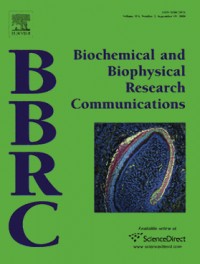Biochemical and Biophysical Research Communications Q2 Unclaimed
""""""""Biochemical and Biophysical Research Communications is the premier international journal devoted to the very rapid dissemination of timely and significant experimental results in diverse fields of biological research. The development of the """"""""""""""""Breakthroughs and Views"""""""""""""""" section brings the minireview format to the journal, and issues often contain collections of special interest manuscripts. BBRC is published weekly (52 issues/year)."""""""" It has an SJR impact factor of 0,748.
Biochemical and Biophysical Research Communications focuses its scope in these topics and keywords: human, protein, expression, cells, factor, cell, gene, mouse, growth, acid, ...
Type: Journal
Type of Copyright: CC BY
Languages: English
Open Access Policy: Open Choice
Type of publications: Research articles, short commu
Publication frecuency: -
2224 €
Inmediate OA0 €
Embargoed OA0 €
Non OAMetrics
0,748
SJR Impact factor298
H Index1415
Total Docs (Last Year)3974
Total Docs (3 years)60175
Total Refs10180
Total Cites (3 years)3967
Citable Docs (3 years)2.31
Cites/Doc (2 years)42.53
Ref/DocOther journals with similar parameters
Journal of Cell Science Q2
Molecular Biology of the Cell Q2
Journal of Cellular and Molecular Medicine Q2
Mitochondrion Q2
Cellular Signalling Q2
Compare this journals
Aims and Scope
Best articles by citations
Inhibition of fungal ABC transporters by unnarmicin A and unnarmicin C, novel cyclic peptides from marine bacterium
View moreStructure determination of a human lymphocyte derived neutrophil activating peptide (LYNAP)
View moreSelection of staphylococcal enterotoxin B (SEB)-binding peptide using phage display technology
View moreActin Polymerisation Regulates Integrin-Mediated Adhesion as Well as Rigidity of Neutrophils
View moreProduction of myeloid cell cytosols functionally and immunochemically deficient in the 47 kDa or 67 kDa NADPH oxidase cytosolic factors
View moreCMKLR1 deficiency influences glucose tolerance and thermogenesis in mice on high fat diet
View moreEfficient inhibition of the formation of joint adhesions by ERK2 small interfering RNAs
View moreDJ-1 binds to mitochondrial complex I and maintains its activity
View moreHelicobacter pylori-stimulated EGF receptor transactivation requires metalloprotease cleavage of HB-EGF
View moreThe effect of long-term treatment with erythromycin on Th1 and Th2 cytokines in diffuse panbronchiolitis
View moreEnhanced apoptosis by a novel gene, Bak-like, that lacks the BH3 domain
View moreEffects of muscarinic receptor type 3 knockout on mouse islet secretory responses
View morePerfusion of veins at arterial pressure increases the expression of KLF5 and cell cycle genes in smooth muscle cells
View moreInhibitory effects of cis- and trans-resveratrol on noradrenaline and 5-hydroxytryptamine uptake and on monoamine oxidase activity
View moreInhibition of the oxidative burst response of N-formyl peptide-stimulated neutrophils by serum amyloid-A protein
View moreChimeric Synthetic Peptides from the Envelope (gp46) and the Transmembrane (gp21) Glycoproteins for the Detection of Antibodies to Human T-Cell Leukemia Virus Type II
View morePertussis toxin inhibits the rise in the intracellular concentration of free calcium that is induced by chemotactic factors in rabbit neutrophils: Possible role of the "G proteins" in calcium mobilization
View morePurification, identification, and characterization of elastase on erythrocyte membrane as factor IX-activating enzyme
View moreCdk inhibitor ste9p/srw1p is involved in response to protein synthesis inhibition in fission yeast
View moreBiophysical studies and modelling indicate the binding preference of TAZ WW domain for LATS1 PPxY motif
View moreConformational alteration of bradykinin in presence of GM1 micelle
View moreFungicidal Effect of Antimicrobial Peptide, PMAP-23, Isolated from Porcine Myeloid against Candida albicans
View moreCaspase 3 activation is controlled by a sequence located in the N-terminus of its large subunit
View moreThe Dual Coated Pit Pathway Hypothesis: Vertebrate Cells Have Both Ancient and Modern Coated Pit Pathways for Receptor Mediated Endocytosis
View more


Comments